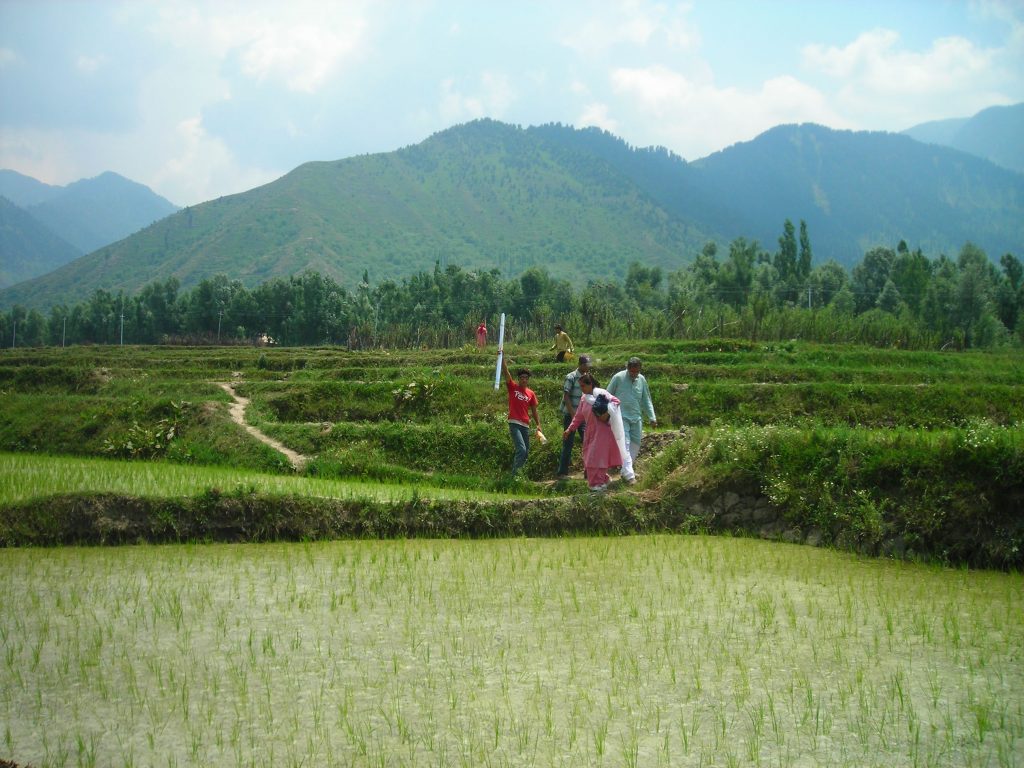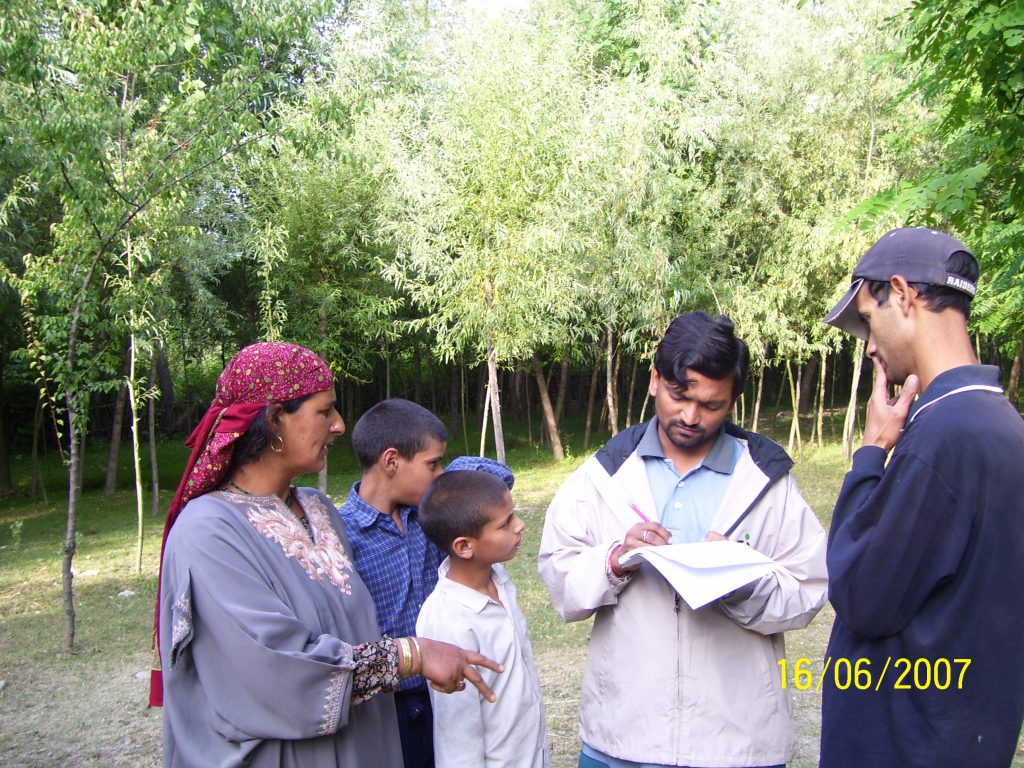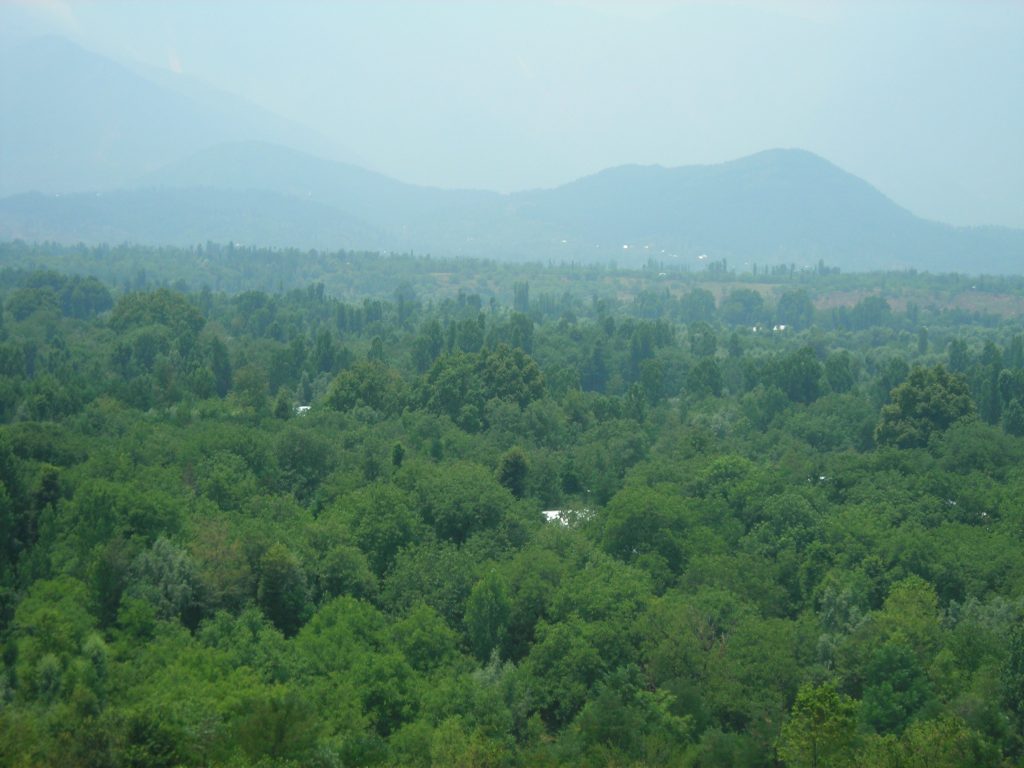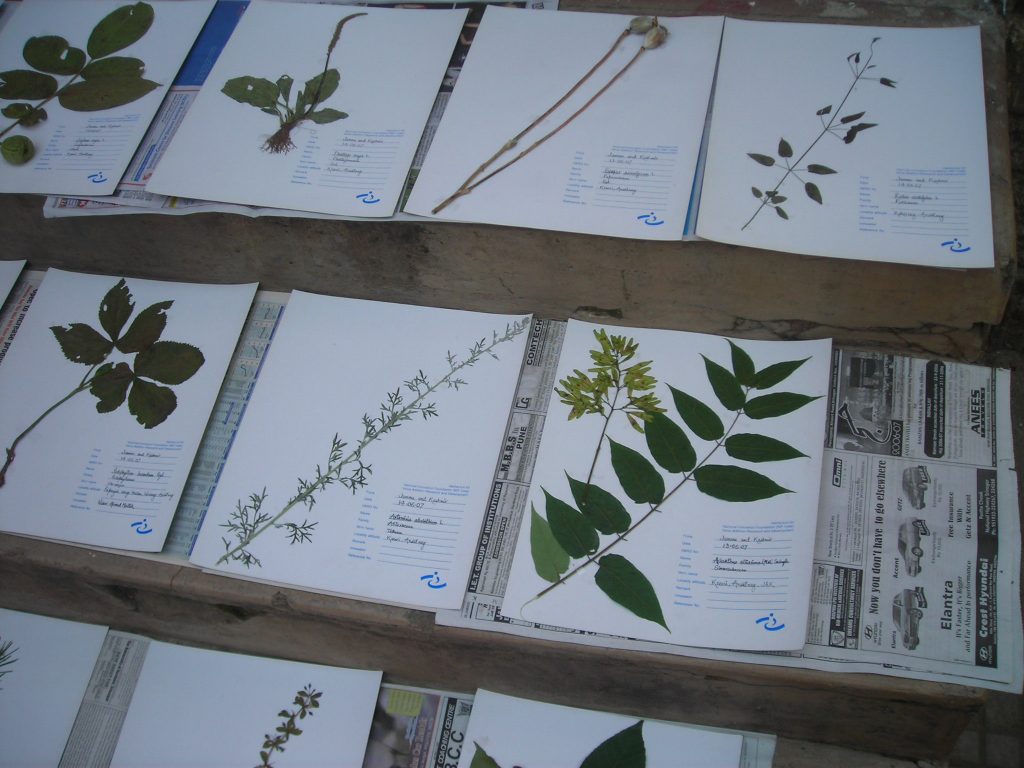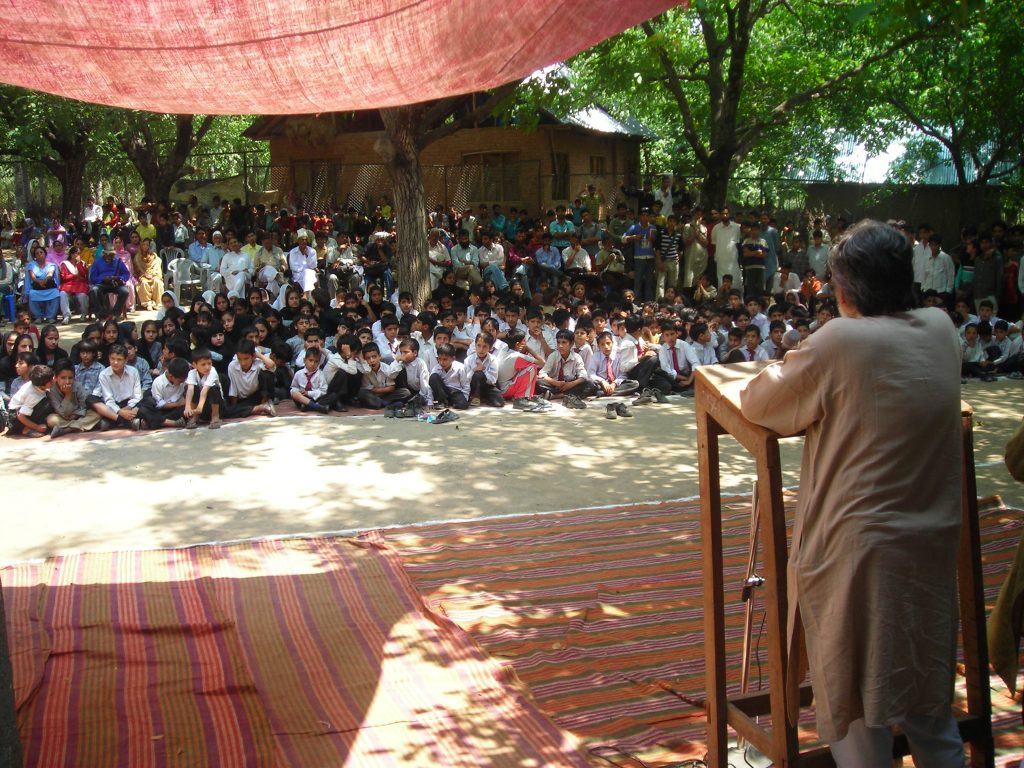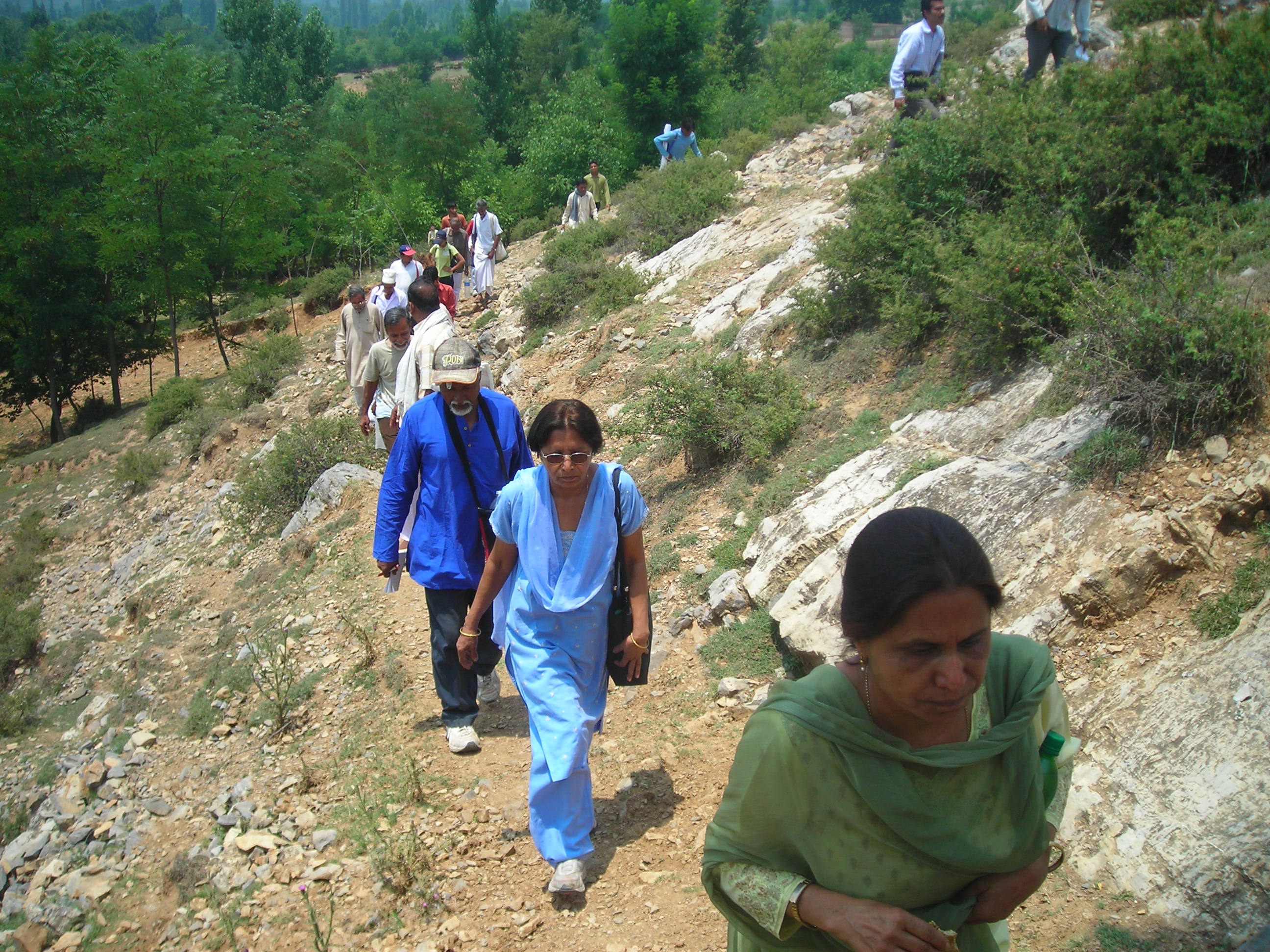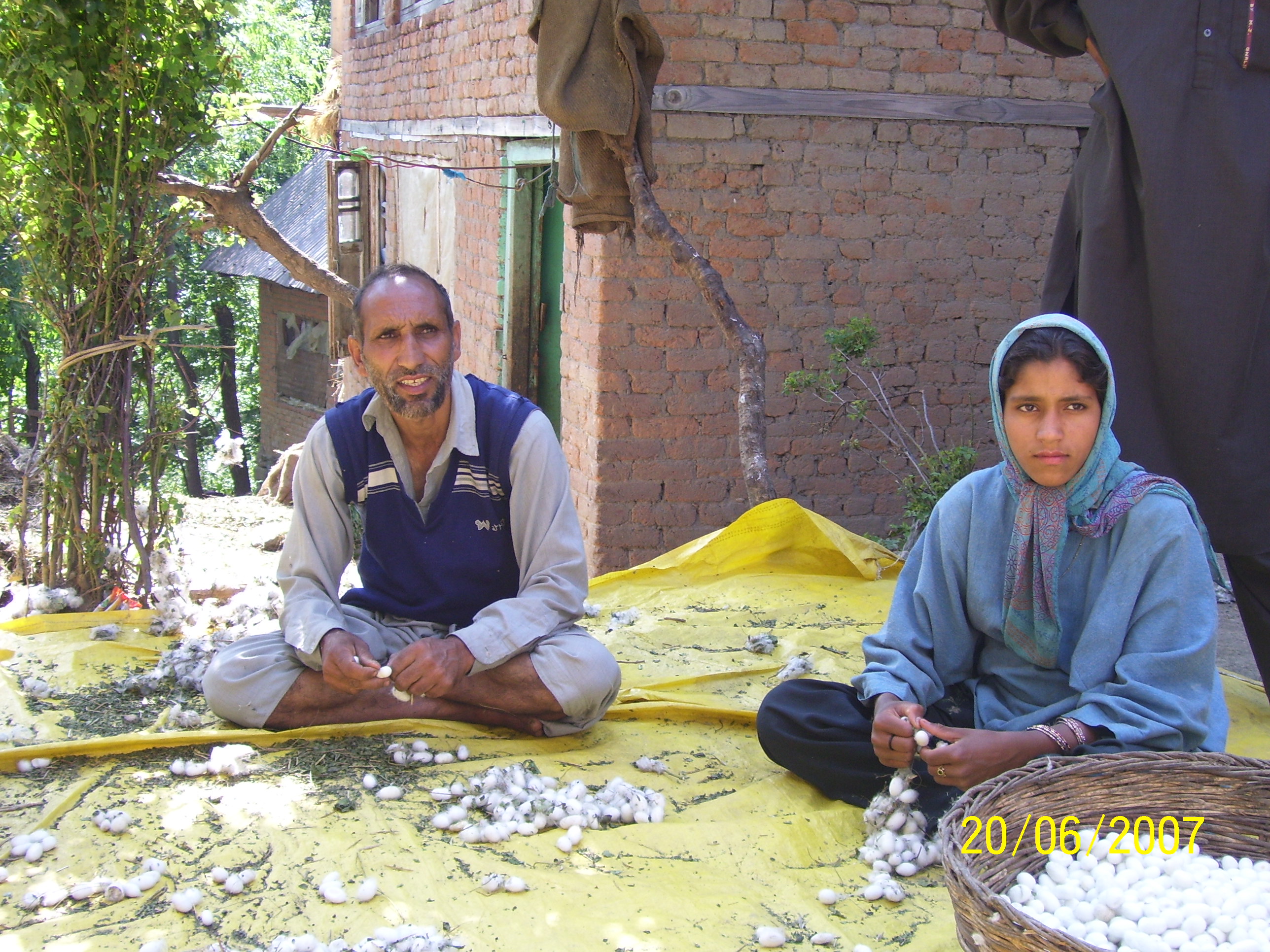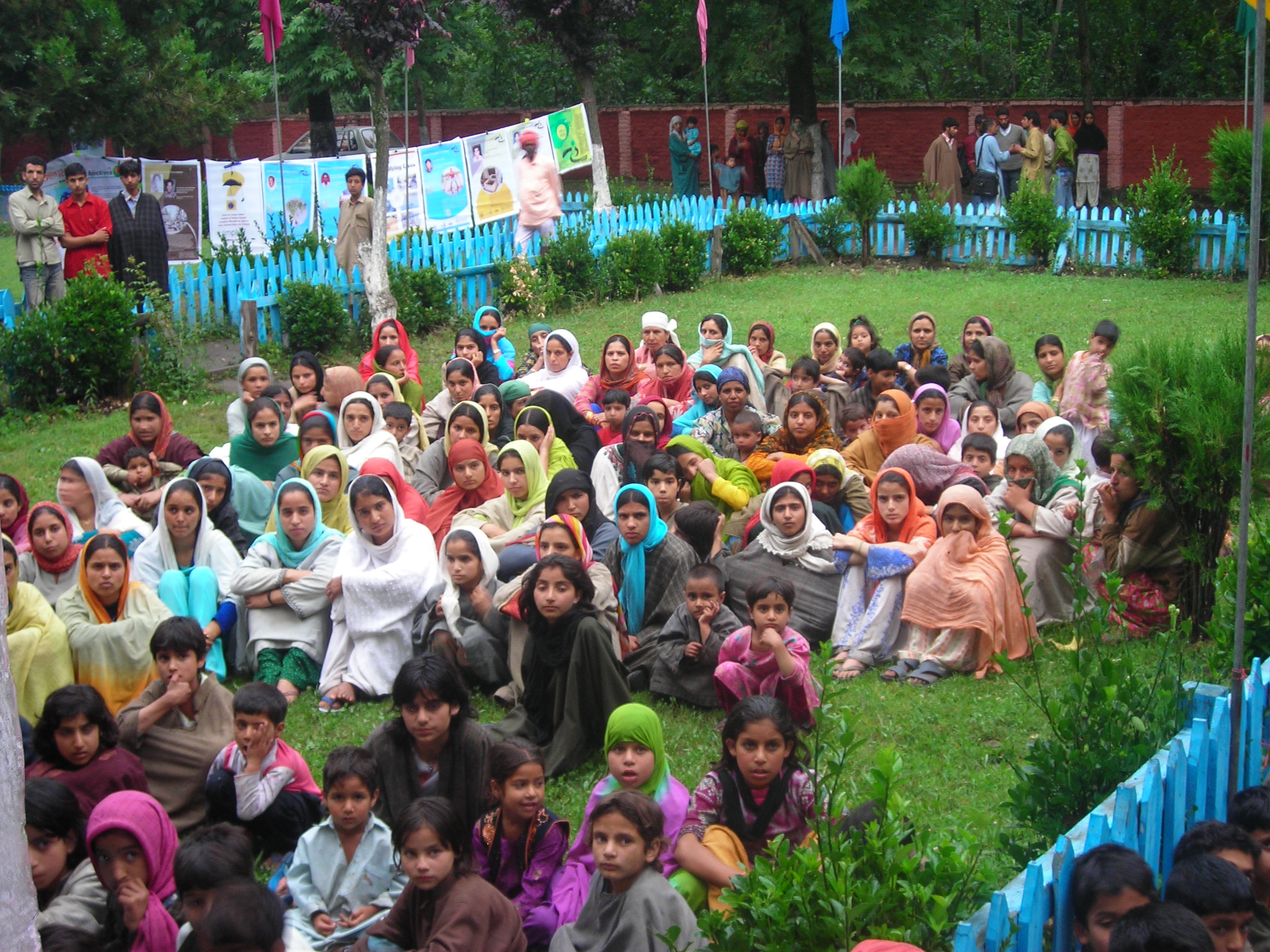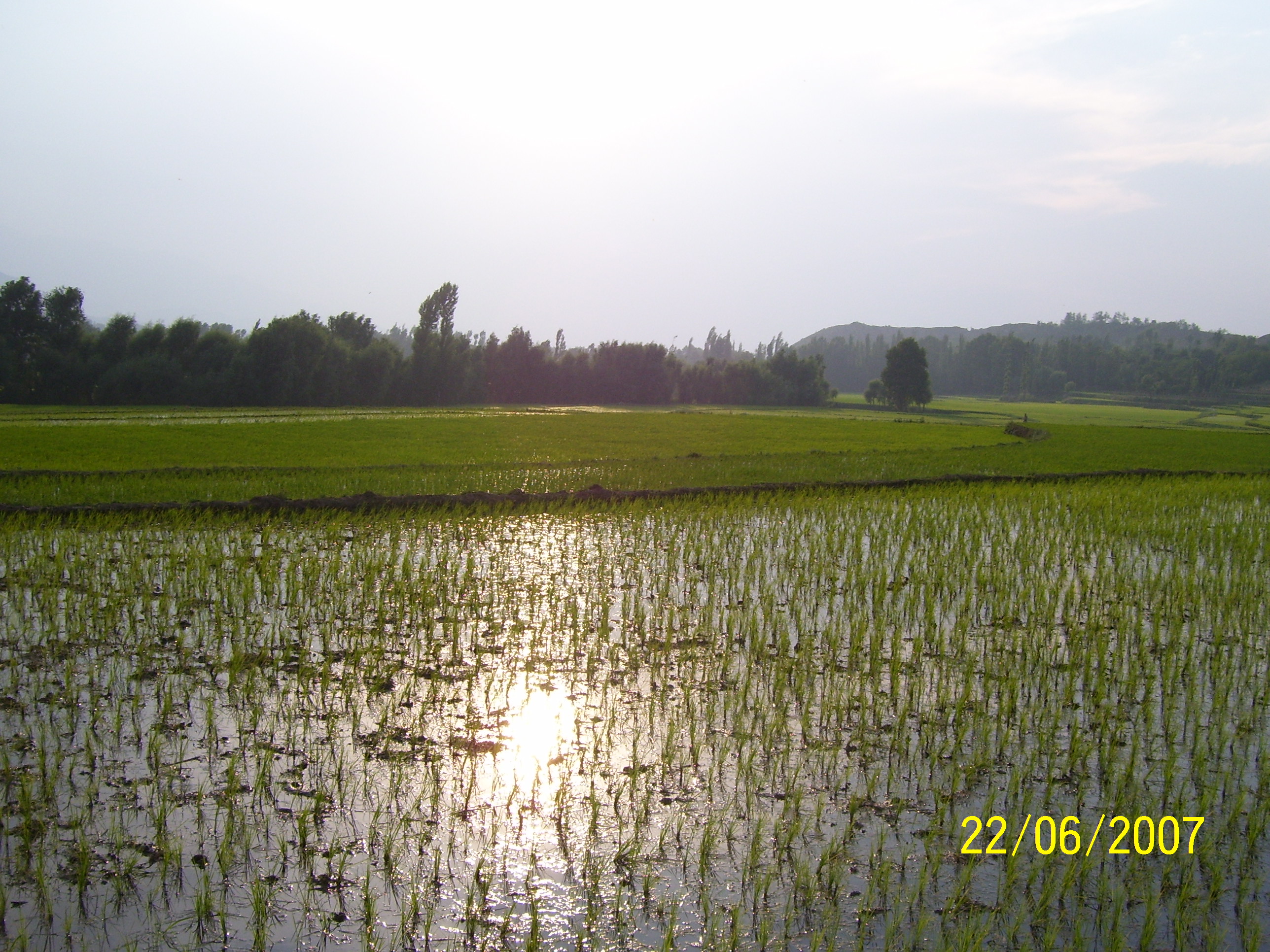Get Next Shodhyatra Update:
Phone:
079-27913293, 27912792
Email:
shodhyatra@sristi.org
19TH SHODHYATRA, KANJIGUD TO ANANTNAG (JAMMU & KASHMIR)
June 20th-27th, 2007
WITNESSING THE BLENDING OF LOCAL KNOWLEDGE AND FORMAL SCIENCE
Witnessing the blending of local knowledge and formal science
There were many Shodhyatris who were not sure as to what was in store for them in a region known for its maximum disturbances. Some had dropped out because of such an anxiety. But there were more than fifty farmers, artisans, professionals, students and others whose skepticism immediately vanished seeing the response of the people. A day before the actual start of the yatra, some of the Shodhyatris went to visit the Department of Applied Electronics, Srinagar University. Dr Bhatt, Head of the Department is assisting Mushtaq Ahmed Dar to improve the design of his innovation of a low cost tree climber and a walnut cracker.
The yatra began from Government Boys High School, Quazigund situated along side a river.
A team of young students, farmers, professionals from Kreri village, mobilized by Zahoor and Mushtaq had organized the Shodhyatra. Yatris were reminded of the two journeys they were going to embark upon. In one, it was known where would everybody be on 27th June, when the yatra would end. But in the other, the inner yatra/journey, every fellow learner had to determine for him/herself as to where has he/she reached. The journey was important for every body given the anxiety in the rest of the country about the conditions in the region. But the trust Honey Bee Network, NIF and SRISTI had gained in the last few years and particularly in the last few months of preparatory work convinced the fellow walkers that the journey must go on, regardless of any other consideration.
FOCUSSING ON THE "HAVES" RATHER THAN "HAVE NOTS"
The inaugural function at the Government Boys High School, Quazigund began with students expressing their concerns about the local region, its declining wild life, loss of forests and biodiversity, increasing pollution of water bodies and the indifference of new entrepreneurs towards the environment. While informally discussing with the local partners, Mr Hilal made a very interesting point about how to explore developmental opportunities in the region. He asked, “Why do we look at what Kashmir does not have? Why do we not focus on what we have in abundance, such as snow, stones, water, biodiversity etc”? He also had many queer ideas. “Can water be used for carrying communication waves, instead of relying on air interfered by mountains? Can snow be used to generate energy?” and so on…
On the way to the Gani Khan Memorial High School, Check, the yatris found a huge power line being laid out. It was said that 11,000 trees were cut for erecting the towers but compensatory afforestation was reportedly not made in the regions where the towers were being erected. Gully erosion was most rampant in the entire region. The yatris walked through these gullies, which stand witness to the tremendous soil erosion going on in this region. No watershed program seems to have been undertaken ever here.
The drought for several years in the region had drained the energy. The Agriculture Department had started rebuilding the infrastructure. A newly recruited team of Agricultural Department, Achhabal were the only field functionaries who welcomed the yatris and cared to meet them and share mutual learning.
The Education Department had been very helpful in informing all the schools on the way and advising them to provide accommodation for the yatris in the schools. The missing panes from the schools windows seemed a rule rather than an exception. If this is the way we care for our children in a region so badly wounded and fractured by the events in the last two decades, nothing else remains to be said.
On the way from Shangas to Utrusoo, the only water driven mill for grinding wheat flour was seen. All along the way, there were a large number of streams and canals but in none could be seen a hydram or any other water based turbine or energy generating unit.
It was ironic that unlike the medical shops in plains where one could find at least 20-30 per cent Ayurvedic or Yunani medicines, the shops in Kashmir lacked the presence of any local or traditional medicines. In Doru, there was only one such shop. In the rest of the way, one did not find any.
Many young people regretted that the lack of knowledge of Hindi prevented them from exploring as many business or livelihood options in the rest of the country as would perhaps have been possible with the knowledge of this language. The feeling of disconnect from the rest of the country was very deep. Media impression about the situation in Anantnag seemed completely at variance from what the yatris experienced.
HONOURING THE CITADEL OF WISDOM AT HER DOORSTEP
Since Mariam Begum, a centenarian could not come to Majmooh village school, yatris decided to go to her house, about three kilometers away in the mountains to felicitate her. Her house was locked when they reached there. The Bakarwal community maintains at least two houses, one in the higher mountains and another near the valley where young children live with their parents to pursue their education. The eighty five year old Mariam Begum was in the other house. But within fifteen minutes she walked down the distance to come to the house where the yatris waited for her. She was felicitated and asked to share her experiences. She explained that many plants were no more found, not only in the valleys, but also in the higher ranges.
The yatris also learnt that all the regions beyond Jammu were parts of Punjab to her. Her language was also far more akin to Punjabi than Urdu or Kashmiri. They preferred goat milk for health because it was said that a goat will graze upon more than a hundred species in a day. The hand sickle they used had an interesting design, with a wooden base below the hand grip, so that one would not hurt his hand while cutting grass very close to ground. The yatris sought her blessings for the success of the mission of Honey Bee Network and continued their journey.
INNOVATIVE IDEAS FROM YOUNG MINDS
In Majmooh, sitting under the walnut tree, the students were asked to explain how one could crack walnuts more efficiently than was the practice? Shakeel, a young student of 8th class came up with the idea of using two wooden strips to press walnut from one side. When challenged that it would help in breaking only one walnut at a time, Shameema came up with a suggestion of extending the wooden strips, and attaching a spring to one side. It is not important whether this design will work better than what Mushtaq has developed. But before the yatris shared the innovation by Mushtaq, they had triggered the virus of innovations.
At Hiller, everybody sat again under a walnut tree in the Government Middle School. Children were very impressed with the demonstration of the tree climber Mushtaq had designed. What was most interesting was that a girl Ruby came forward to test the climber herself. Teachers encouraged girls to face the challenges at par with the boys. Time and again, it was found that the teachers were quite keen to encourage students to explore, be free and unrestrained in asking questions. Motivation levels of the teachers in both government and private schools seemed very high.
In the Government Boys High School, Sagam, when asked to design a walnut cracking machine, Jasser mentioned that one could use two screw-like drums to break the nuts. This seemed a distinct improvement over what the Srinagar University engineers had designed so far. May be not. But the idea merited a detailed discussion between him, Mushtaq and Dr Bhatt of Srinagar University. Jasser had many more ideas in mind, like an idea about designing a vehicle, which could work on the principle of using compressed air to propel it. A meeting between him and the faculty of the Srinagar University was suggested through Dr Bhatt, who was already mentoring Mushtaq.
Among other things, what impressed the yatris most was the enthusiastic response of the students, particularly girl students in sharing their knowledge with them. Shodhyatris had been asked about the remedy for frost bite in many villages. But they had no answer. At the Government Higher Secondary School, Mattan, a student, Dansihta Faroq shared a practice she had learnt from her mother about solving this problem.
After making a turnip into a bowl by scooping out the center portion,
Shakeel explaining his idea of cracking walnuts
one had to boil mustard oil in it. This oil apparently provided relief in frost bites. It was not a difficult thing to prove. But, this information had not reached other villages.
The plan of two hundred years of journey was mentioned in every school the yatris went to. The knowledge of great grand parents had been brought forward with whatever limitations to present generation, spanning a hundred years that have passed by. The challenge was to create a process by which relevant and functional knowledge will be transferred to coming generations, the grandchildren of the children today for the next hundred years. The need for building Village Knowledge Registers (VKRs) was stressed so that these registers could be linked with the National Register of Grassroots Innovation and Traditional Knowledge maintained by the National Innovation Foundation. The idea of pooling the best practices dealing with herbal knowledge so as to develop new products was shared as a basis for generating new jobs as well as enterprises.
NO CELEBRATION FOR FIFTEEN YEARS
Time and again, in Sadiwara, Verinag, Nagam, Batagund, Bragam, Kreri, Lisser etc., every school where we had a meeting, interaction with the students revealed one painful fact. For the last fifteen to twenty years, no function had taken place. A whole generation had grown up without knowing what it meant to celebrate collective joy, have fun, and display one’s talent. Not many outsiders
seemed to have visited these schools, even for ceremonial purposes. This meant a very rich feast of cultural presentation by students in every school we went. The stay at Kreri village from where most members of the voluntary team had been mobilized was very eventful. Three schools had organized a very rich cultural program for our welcome in addition to a recipe competition. The “chutney” of apricot was a novelty, which most people year arts course. He wanted to do an ITI course in electrical fittings and start a shop of his own. He had been learning this from his maternal uncle. The small farm that he shared with his uncle did not fetch sufficient income for the family.
He gave an application to the principle for leave and came with us. When asked if he would not lose out on studies, he said that he had already learnt what the teacher was going to teach in that period.
Aquib Javed joined us from Doru. His father worked as a ranger in the Forest Corporation.
He learnt the herbal preparations from his maternal grand mother (Nani) who passed away a few years ago. He used to observe her making various herbal concoctions and got interested in the same. He showed us “Gulkand” (a kind of preparation of rose petals with sugar after a few months of fermentation in an air tight container), which when taken with hot water helps clear throat congestion and is also good for health. He had brought some other herbs from which he made a “Churna” (a powder formed by grinding the dried contents) for indigestion and another for curing worms in the stomach. He wanted to do Ph.D in Botanical sciences and contribute something useful for the society. There were two students who joined us from Kokernag, Syed Intekhab Firdaus and Saifjan Wani. They had also helped the scouting team earlier.
MEMORIES OF THE NEIGHBOURS WHO MIGHT RETURN SOME DAY
While walking to Kokernag, we met three young people who were curious to know about our walk. One of them worked in Police department and the other two were students. They told us about the gardens Pundits of the region had maintained, the ruins of their houses, temples and the rest
They recalled how they used to celebrate all the functions together; join each others’ parties and marriages. They regretted that the Pundits had migrated and felt uncertain about their coming back. It was destiny they felt, which might decide about the timing of their return.
had not heard about. It was also believed to have nutraceutical properties.
YOUNG LEARNERS WHO JUST STARTED WALKING WITH US
Spontaneity of the spirit of Shodh Yatra was captured in a memorable way by the decision of two young students
who started to walk with us after interacting with us. Ahmer Hussain Jan, a student of tenth class joined us from the first day itself, when we started the Shodh Yatra from Quazigund. He had lost his father, had a younger sister and an elder brother who studied in Srinagar in first.
Earlier when we had passed by Watishtha Ashram, the young locals showed us the ruins of the houses of Pundits. They mentioned how during the days when they were there, they would not let any one take bath in the holy pond. They always wanted to maintain the sanctity of the stream, which originated there. Those norms had weakened in recent times. The parting of a community, which was woven together in the mixed (mili-juli sanskriti, tehjeeb) culture of Kashmir had not brought solace to any one. It seemed to reverberate in the minds of local communities almost always with affection and nostalgia. Those who divided the community might not realize the scars they have left behind. But the yatris felt quite optimistic about the possibility of their coming back.
We moved to Shangus village where we honoured some of the Traditional Knowledge holders in a roadside meeting. While entering the village, on the way, we saw a beautiful house. The walls of this house seemed to be painted with clay, but had absolutely no mark of rain or dust. We decided to enter the house and find out more about the impressive architecture. What we learnt was quite a revelation. It was a house of a weaver, made of
unbaked clay bricks.
It was plastered with clay mixed with gunny bag fibre (jute), without any use of concrete. More than 30 years old, the house looked very new. It was reported to keep warm in winter and cool in summer. It was also safe during earthquake.
Later we heard that people felt that modern architecture involving baked bricks and concrete walls and floor was perhaps a reason for people having frequent back pains.
While walking towards Deethu – Reenipora, we saw a row of trees closely planted.
On enquiry, we were shown an abandoned house of a Pundit family, for which these trees acted as a natural curtain and a noise-block. In Soafsali village, we met a physically challenged person, Firdoos Ahmed Matkoo, who had a great gift of making
clay toys and components resembling the ones made of metal. The finish was so perfect and the surface so smooth that it was difficult to believe that it was a hand crafted product. In Mattan, we saw the famous sun temple. A middle aged Muslim farmer came running on seeing us. He thought we were the Pundits who were returning home. When he came close, he just said, “I want to say Ram Ram to you”. The Shodh yatris were deeply struck by this pure demonstration of love and respect. The sun temple was also called Pandava’s temple made in sixth or seventh century. It had prayer rooms for large number of devotees and stone idols of Ganga, Yamuna and Saraswati.
The yatra officially ended with a meeting at the Boys’ Degree College, Anantnag. After we introduced ourselves and explained the purpose of our yatra, a student asked, when did you first come to Kashmir? When we answered that it was 2005, he was dismayed. Why did we take so long? Another student commented as to where were we
for last 47 years. This summed up the situation. Why had we not engaged with them for so long?
A thought that has remained with us since then, unresolved, uneasily but persistently.
SINGING LANTERN
Born in a farmers’ family, Ghulam Mohammed Meer was a naughty yet studious boy. His interest in all kinds of mechanical and electronic devices since his childhood made him take up an ITI course after his matric. He wanted to make a career out of it, but he could never get a job. He returned home to take care of his land but continued experimenting with all he could do. He claims to have made a small toy helicopter many years ago, which flew away never to return. He also made a battery charger and modified many other items of daily use including the traditional wooden load carrier by incorporating lights and brakes in it.
The commonly used lantern intrigued Meer. He used to think why it could not be used for some other purpose as well. A person walking in the night or working in the light of the lantern needs some entertainment. This thought prompted him to make some changes in the traditional lantern and he came out with his ‘Singing Lantern’.
The innovater has fitted a battery in kerosene chamber of an existing lantern. It works for light as well as radio. The battery can be charged by solar pannel too.
DISABLED ENABLED CAR
Born in a family of nine, Mr Abdul Rashid (46) had a difficult childhood. He got affected with polio at an early age, which rendered his left leg totally dysfunctional and the right one around 60 per cent useless. His father worked as a tailor and died when Rashid was only sixteen years old. He had to struggle with his own physical limitations, and had to get his five sisters married off, because his brother had shied away from his duties and left the family.
Since Mr Rashid could not go to school, he learnt tailoring and even started training others interested in the job. Till now, he has trained around fifty people who have in turn trained many more. His wife is also a tailor and both of them work hard to maintain a decent earning.
All the adverse conditions in his life made Rashid stronger and determined to fight. He always wanted to meet his sisters and their family but was limited in movement because of his physical condition.
Public transport was cumbersome and did not allow him much flexibility of time. At the same time, he wanted to be free from dependence on others for his movement. He wanted to purchase a car so that he could move around freely without anybody’s help.
He approached Maruti Company for making a suitable attachment for him. The price quoted by them was almost 90,000 Rupees, which Rashid was unable to pay. Therefore, he decided to buy a second hand car and modify it himself. Spending only Rs 100, Rashid attached a rod to the clutch pedal so that it could be pressed. He also put a small hook to hold the pressed rod (and the clutch) so that he could free his hand and change the gear. Once the gear is changed, the rod is unhooked and the clutch released. This is the simple functioning of the mechanism.
PORTABLE TREE CLIMBER
It is a simple tree climbing device to climb up a tree made by Mushtaq Ahmad Dar of Kreri village. The device comprises of a wooden lower support, which includes a foot platform and tension wire made of mild steel. The lower support comprises two rectangular wooden blocks; one is fitted inside the other at an angle ranging from 30 to 45 degrees. The device/unit gets locked around the stem of the tree through tension wire due to the weight of the user.
The user needs to transfer his weight from one set to another (fixed with either leg) while climbing up and can move up easily regardless the height of the tree. One can also take rest while climbing when desired. Unlike other tree climbers, this apparatus is compact and very cheap. In addition, it can be used on a variety of trees and even poles.
FLICKR GALLERY
